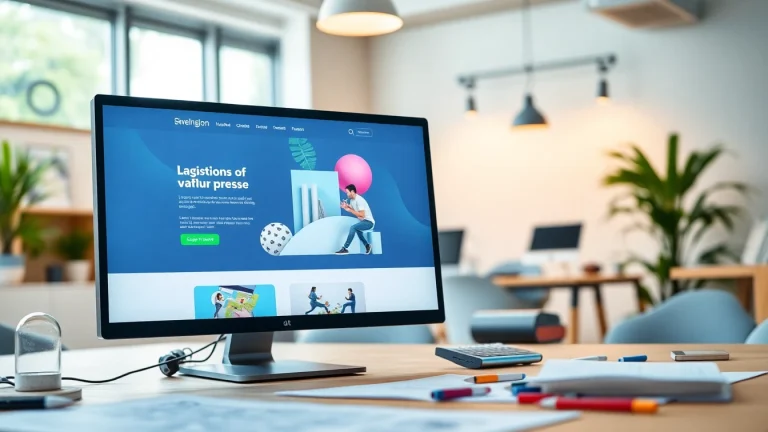
Essential Elements of Effective Website Design for Business Growth
Understanding the Basics of Website Design
Website design is more than just aesthetics; it’s about creating an engaging and functional interface that guides users through a digital experience. From layout to usability, understanding the foundational elements can enhance how web users interact with your site.
What is website design?
Website design encompasses various skills and disciplines involved in the production and maintenance of websites. Central to this field are elements such as web graphic design, user interface design, authoring, and standardized coding practices. In short, it refers to the visual and functional aspects of a website that make it usable and enjoyable for visitors. An effective website design facilitates ease of navigation and provides a seamless user experience.
Key principles of website design
- Clarity: Clear navigation and well-defined hierarchies ensure that users can find what they’re looking for without confusion.
- Consistency: Maintaining a uniform style across pages fosters a cohesive brand identity.
- Responsiveness: A responsive design adapts seamlessly across various devices, enhancing user accessibility.
- Visual Hierarchy: Using size, color, and layout to guide users’ attention emphasizes crucial elements like calls to action (CTAs).
- Accessibility: Design should accommodate users of all abilities and disabilities, ensuring the content is usable for everyone.
Common mistakes in website design
While designing, many tend to overlook fundamental aspects that can negatively impact usability. Some common mistakes include:
- Overcomplication: Excessively busy designs can overwhelm users and dilute the core message of the site.
- Poor navigation: Complicated navigation structures can frustrate users and lead to high bounce rates.
- Neglecting mobile users: In an increasingly mobile world, failure to optimize for smartphones and tablets can alienate a significant portion of your audience.
- Ignoring load times: Slow site speeds can detract from user experience, leading to increased abandonment rates.
- Not conducting user testing: Skipping user testing can result in overlooked usability issues that may hinder performance.
Effective Strategies for Stunning Website Design
Creating an appealing and functional website requires strategic planning and execution. Here are vital strategies to consider:
Choosing the right color palette for website design
Color influences emotions and perceptions. Selecting the right palette is crucial for creating an impactful site. Consider these tips:
- Understand color psychology: Colors evoke specific feelings; for instance, blue can convey trust, while red can create urgency.
- Limit your palette: A simpler palette can simplify design and enhance brand recognition.
- Use contrasting colors: High contrast between text and background improves readability and user experience.
- Test your palette: Always gather feedback on your color scheme from potential users.
Importance of responsive website design
Responsive design ensures that users have a positive experience no matter what device they use. Here’s why it matters:
- Wider audience reach: With the rise in mobile browsing, a responsive site attracts more users by accommodating various devices.
- SEO benefits: Google prioritizes responsive sites in search rankings, enhancing your visibility online.
- Improved user engagement: Users are more likely to stay on and explore a site that functions well on their devices.
- Reduced bounce rates: A seamless experience across devices leads to lower abandonment rates, as users find it easier to navigate.
Integrating visuals for enhanced website design
Visuals play a pivotal role in engaging visitors and conveying messages effectively. They can include images, videos, infographics, and more. Focus on the following:
- Select high-quality images: Poor-quality visuals can damage the site’s credibility; invest in professional images whenever possible.
- Use videos strategically: Videos can convey complex information quickly and enhance user involvement.
- Optimize visuals: Compress images and videos to maintain fast load times without sacrificing quality.
- Maintain relevance: Ensure all visuals align with your brand message and support your website’s goals.
Tools and Resources for Website Design
Leveraging the right tools and resources can streamline your website design process and enhance the quality of the final product. Here are essential categories to consider:
Popular software for website design
Numerous software options exist, catering to various needs in website design:
- Adobe XD: Ideal for wireframing and prototyping with vector graphics.
- Sketch: A user-friendly interface design tool favored for creating interactive designs.
- Figma: A collaborative design tool that allows real-time teamwork on designs.
- Canva: Excellent for creating visual content easily, with drag-and-drop features and a variety of templates.
Website design templates and frameworks
Utilizing templates and frameworks can save time and inspire creativity:
- Bootstrap: A front-end framework that simplifies responsive web development.
- WordPress Themes: A plethora of customizable themes exist for various website types.
- HTML Templates: Pre-built HTML templates provide a foundation to build upon for speedier development.
- Website Builders: Platforms like drag-and-drop builders make it easier for non-coders to create sites.
Learning resources for website design skills
Continuous learning is vital for developing and improving your website design skills. Consider these resources:
- Online courses: Websites like Coursera and Udemy offer comprehensive courses from industry experts.
- Books: Investing in good literature on design principles can deepen your understanding.
- YouTube tutorials: A wealth of free content exists to help you master various design tools.
- Design blogs: Following industry-leading blogs keeps you updated on the latest trends and best practices.
Optimizing Your Website Design for SEO
Creating an aesthetically pleasing website is important, but ensuring it ranks well in search engines is crucial as well. Here are strategies for SEO optimization:
Understanding SEO in website design
SEO can dictate how visible your site is when users search for relevant keywords. The integration of SEO-friendly practices from the outset is critical. Key aspects include:
- Keyword placement: Effective placement of target keywords in title tags, headers, and content improves visibility.
- Mobile-friendliness: Google considers mobile responsiveness as a significant ranking factor.
- Fast load times: Optimizing images and code can drastically improve loading speeds, affecting bounce rates and rankings.
- Structured data: Utilizing schema markup helps search engines understand your content better, enhancing SERP features.
Best practices for SEO-friendly website design
Implementing these best practices can make a substantial difference in your website’s SEO performance:
- Optimize URLs: Keeping URLs short, descriptive, and relevant makes them more appealing for users and search engines.
- Improve navigation: Internal linking and a clear hierarchy lead users smoothly through your site and assist in indexing.
- Utilize alt text: Include descriptive alt text for images, aiding both accessibility and SEO.
- Content updates: Regularly updating content signals to search engines that your site is active and relevant.
Analyzing website design performance metrics
Measuring the effectiveness of your website design through analytics can provide insights that inform future enhancements:
- Traffic analysis: Use tools like Google Analytics to monitor user behavior and traffic sources.
- Bounce rates: High bounce rates may indicate issues with design or site content.
- User feedback: Gathering direct feedback from visitors can highlight areas needing improvement.
- Conversion rates: Tracking conversions informs how effectively your design drives user actions.
Future Trends in Website Design
The digital landscape is ever-evolving, requiring a constant adaptation of website design strategies. Here’s what to expect:
Emerging technologies in website design
New technologies can significantly enhance user experience and site functionality:
- AI Integration: AI tools can assist in personalizing user experiences, predicting user needs, and automating routine design tasks.
- Voice Search Optimization: With the rise of voice search, designing for this modality will become increasingly important.
- Augmented Reality (AR): AR can offer immersive experiences, particularly in sectors like retail and real estate.
- Progressive Web Apps (PWAs): PWAs provide a native app-like experience while retaining the core benefits of a website.
Predicted trends shaping future website design
Several key trends are likely to shape the future of website design:
- Minimalism: A trend towards simplicity continues, focusing on essential elements to minimize distractions.
- Microinteractions: Subtle animations and feedback mechanisms enhance user engagement and experience.
- Accessibility-first design: Prioritizing accessibility not only meets legal requirements but broadens user inclusivity.
- Data-driven personalization: Tailoring visitor experiences through gathered data enhances engagement and conversion opportunities.
Adapting website design to changing user behaviors
As user behaviors evolve with technology and culture, designing flexibly is crucial. Here’s how you can adapt:
- Stay updated with user trends: Regularly assessing user preferences ensures that your design meets current expectations.
- Experiment with layouts: A/B testing different layouts can reveal what resonates most with users.
- Gather data insights: Utilizing heatmaps and analytics helps in understanding where users interact most on your site.
- Foster a culture of user-centric design: Prioritizing user feedback during the design process helps create more effective online experiences.


